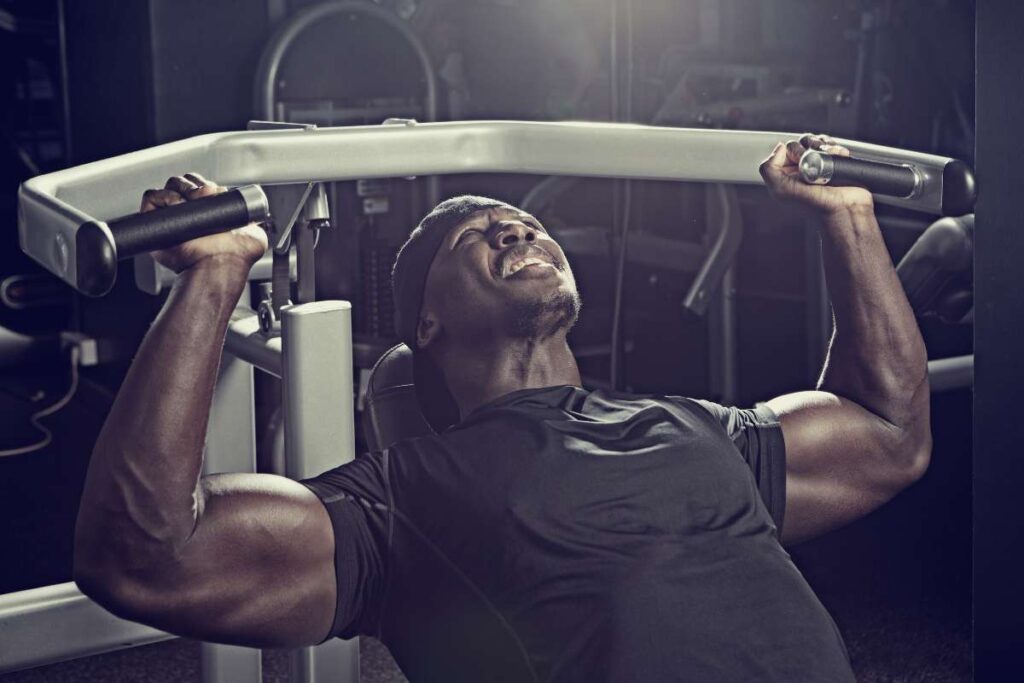This post may contain affiliate links at no additional cost to you. As an Amazon Associate I earn from qualifying purchases. Click to view our full disclosure.
What's inside
Have you ever entered the gym and wondered what training style suits your goals?
Or, maybe you’ve been training for mass for a while but are wondering if it’s time to switch over to the dark side and train for strength.
It can be a difficult choice as you fear the loss of your gains and becoming a novice again.
However, never fear. Hypertrophy versus strength training is an internal debate that many lifters face regularly.
As a trainer, people consult me about this all of the time. The truth is, it isn’t so tough to navigate provided you have the right info.
Today, I’ll break down the difference between hypertrophy and strength training to help you decide on the proper training style.
Let’s jump in.
What is the difference between hypertrophy and strength training?
Related: Full Body Workout Every Other Day
Training for muscle hypertrophy is based on increasing the cross-sectional area of a muscle. Strength training is based on maximum output and performance.
Hypertrophy is typically performed with a repetition range of 8-12, at 60%-80% of one repetition maximum (1RM).
While strength training is based on moving more weight, the research identifies sets of one to five reps at 80%-100% 1RM.
What is hypertrophy training?

Hypertrophy training is done to increase the cross-sectional area of a muscle.
This is typically done by performing movements that target muscles rather than specific movements.
And while larger compound movements are used, hypertrophy training utilizes a mixture of movements to stimulate muscle growth.
This includes smaller compound movements and isolation exercises that target a specific muscle.
Research indicates that performing three to six sets of 8-12 repetitions at 60%-80% 1RM with 60 seconds of rest is best for promoting muscle hypertrophy.
What are the benefits of hypertrophy training?

Here’s why people focus on hypertrophy training.
Increase Muscle Size
The major benefit of hypertrophy training is increasing muscle size. Bigger muscles are a common goal for aesthetics or competitive performance.
A combination of mechanical tension and mechanical stress should be used to increase muscle mass.
Increase Strength
Hypertrophy training can be beneficial in increasing muscular strength.
While increasing muscle mass may not have the same benefits as strength training, there can still be improvements.
This can be represented in the number of repetitions during your session or performing daily living activities like lifting heavier objects.
Improves Muscle Endurance
Hypertrophy training is also known to improve muscle endurance, as it requires a degree of metabolic stress.
Research identifies that increases in the volume of training are beneficial to increasing mass.
With the increase in volume comes greater stress on the muscles, increasing endurance. This helps you continue leveling up in your training.
Energy Expenditure
While weight loss is often characterized by cardio, weight training plays a powerful role in burning calories.
For those looking to increase muscle mass, it is recommended that you should have at least a 15% calorie surplus to build muscle.
This is to fuel the body for the routine.
Hypertrophy training is best performed with increased volume, and with this a great expenditure for energy.
Increase Bone Mass
As we train to increase muscle mass, our bones also increase in mass.
Hypertrophy training and resistance training has long been associated with improving bone density. Research shows that resistance training increases the formation of new bone mass when exposed to new mechanical loading.
Strengthen Muscle Imbalances
Hypertrophy training is a great way to address muscle imbalances, as the style of training focuses on specific muscles.
This may be more noticeable for beginners or individuals returning from injury when they notice areas are weaker from trauma or lack of use.
When you undergo hypertrophy training, you will notice these weaknesses in the form of performance or fatigue.
Targeting these areas can help improve your function and performance, allowing all contributing muscles to perform at their peak.
Do you want to get stronger and build muscle? Check out 4 Day Workout Split: (2022) Ultimate Routines For Strength And Muscle Growth
What are the drawbacks of hypertrophy training?

Below is a list of drawbacks you may find with hypertrophy training.
Less Effective For Building Strength
Hypertrophy training is less practical for building strength compared to strength training.
While it can have the benefits of building strength as it uses principles of progressive overload, it will not be as effective.
This is due to the load being moderate with the focus being on fatigue of a muscle for growth.
Meanwhile, strength training is focused on training for movement, performing repetition of pushing maximum loads.
Reduced Recovery Times
Hypertrophy training requires less recovery between sets to help promote muscle growth.
This may not be a concern to many, but it’s worth considering if you lead a busy lifestyle or don’t want to work out so much.
Hypertrophy can require more sessions in the gym to get through the variety of exercises. Remember – this style of training focuses on targeting specific muscles rather than movements.
Hypertrophy also works best with greater volume, meaning there’s more work to be done in the gym.
And with the addition of split routines to consider if you are wanting to increase your results, there may be less recovery time before intense training sessions.
What is strength training?
Related: What Is Functional Strength Training?

Strength training is weight lifting with a focus on increasing strength. Movements for strength training are centered around moving as much weight as possible.
To train for strength, it is scientifically recommended that you perform sets of one to five repetitions, with a one to three-minute rest between sets.
Allowing the body to restore its energy for maximum output with every rep.
What are the benefits of strength training?
Here are some of the biggest reasons to consider strength training.
Confidence Boost
Strength training can be a great way to improve your confidence. The method of training is based around challenging yourself and pushing your physical boundaries.
While training for mass does challenge you to lift heavier, strength training’s sole purpose is to push through personal records.
And when you succeed in breaking records and hitting your goals, your body will release dopamine, giving you that sense of achievement and boosting your confidence.
That may be all you need to stay consistent and motivated in the gym.
Performance Enhancement
Strength training is an excellent way to enhance performance, as it recruits few reps with higher intensity and greater effort.
Studies illustrate that strength training can improve maximal strength and reactive strength.
These both play an important role as they can improve other lifts in the gym and sports that you may be participating in.
Strength Improvement
The prescription of strength training (heavyweight and lower resistance) has been indicated to be the best way to improve strength.
Research shows that performing sets of one to five repetitions is beneficial to enhancing neuromuscular adaptations that are responsible for generating great force.
Body Fat Reduction
As we progress with our strength training, we build mass and burn energy.
A study shows that strength training combined with dietary intervention is beneficial to reducing body fat and building lean muscle mass.
Improves Mood
Strength training can be an excellent practice to help improve mood.
Some research has identified that strength training in adolescence improved anxiety and depressive moods. Further studies showed reductions in confusion, tension, and anger in older adults.
Increased Bone Density
Strength training, similar to hypertrophy training, is known for increasing bone mass.
As we challenge the body to great feats of strength through resistance training, our bone mass also increases to support our muscle.
Strength and resistance training is recommended to older adults as an intervention to preserve not only muscle mass but bone mass, and to combat osteoporosis and sarcopenia (loss of muscle).
Are you considering strength training for your next program? Check out The Best 10-Week Powerlifting Program For Strength Gains (with PDF)
What are the drawbacks of strength training?

Here are a few things to consider before you dive into strength training.
Greater Fatigue
Strength training can lead to greater fatigue compared to hypertrophy training.
Research suggests that the more we increase the intensity and approach the one-repetition maximum, our body will experience fatigue and soreness.
This may require greater recovery times between sets and during strength training sessions.
Injury
A drawback of strength training there may be an increase in injuries.
Similar to sports where the focus is performance-based, we can often lift to capacity. Even with our best efforts, our technique may falter.
This is when an injury can occur.
This by no means makes it a bad style of training, but it’s worth watching out for every session.
Less Effective at Building Muscle
Strength training, while great at increasing your maximum output for lifts, is less likely to build muscle mass.
While this type of training does increase lean body mass, it does less effectively than hypertrophy training.
This can be due to the style of training focused on movements rather than isolated muscle contractions.
Things to Consider When Choosing Between Hypertrophy and Strength Training

When choosing between hypertrophy and strength training the most important thing to consider are your goals.
If you’re training for sports and not your appearance, strength training may be for you.
If you want to build a strong and lean physique, a hypertrophy workout will likely be more your thing.
Other factors such as the amount of time you can commit to training, current injuries, and preferences of exercises can come into play.
If you find that you have only a few days you can train, then perhaps strength may be for you.
When recovering from an injury, perhaps a more controlled approach of hypertrophy training may serve you better.
Ultimately, it may even simply come down to exercise preference. If you like big compound lifts such as bench presses, squats, and deadlifts, strength is more your game.
If it is a combination of both, you can program a mixture of strength sets for your large compound lifts and add hypertrophy training for your smaller movements.
In the end, choose the one you will enjoy the most and be able to commit to.
Hypertrophy Training vs. Strength Training
Below are a variety of categories to help you compare hypertrophy training and strength training. This can help you make a decision on which is best for you.
Reps & Sets
Repetitions and sets are where these two styles of training vary greatly.
To recap, strength training uses heavy loads for fewer reps (one to five) with a focus on maximum force production.
Hypertrophy exercise is focused on moderate resistance and repetitions (eight to 12) to promote growth.
Rest Period
The amount of rest you get between sets varies greatly for each style of training.
A hypertrophy training program is about creating a degree of metabolic stress and fatigue in the muscle to promote growth.
This means that we require a shorter rest period.
The goal of strength training, on the other hand, is to move as much weight as possible.
With this in mind, rest periods of one to three minutes are recommended so that individuals can recover and push with the maximum effort the following set.
Intensity
Both styles of training have their own type of intensity.
Hypertrophy training’s intensity comes in the form of creating metabolic stress and pushing muscles with moderate resistance with short rest times.
While strength training is the intensity that comes from lifting heavy in short bursts, but with longer rest.
Exercise Selection
Exercise selection for hypertrophy and strength training can share exercises.
However, hypertrophy training targets muscles and strength training builds on movements.
Hypertrophy training uses movements such as squats, bench presses, and deadlifts, but at moderate rep ranges to promote muscle growth.
It may also incorporate smaller compound movements such as rows, presses, and isolation exercises to build specific muscle groups.
Strength, on the other hand, focuses mostly on performing the bench press, squat, and deadlift with maximum effort.
It can also incorporate smaller compound movements as accessory exercises to help build these larger lifts.
Still, the major focus for strength is to build towards lifting the heaviest load possible.
Number of Exercises
Related: How Many Exercises Per Workout?
The number of exercises for hypertrophy and strength training differs greatly.
Strength will typically focus on fewer exercises with a focus on strength output and execution.
Hypertrophy training requires you to stimulate muscles and muscle groups.
Here, there is an increase in exercises to target different areas and specific muscles while increasing training volume for muscle growth.
Progressive Overload
Progressive overload applies to both hypertrophy and strength training.
Although they are slightly different, strength may require small increments as you will be pushing the maximum weight with your sets for fewer reps.
With hypertrophy training, you will be progressively overloading in smaller increments for more reps.
This gives you more opportunity to adjust between exercises and even sets.
An example of this is performing gradual increases of weight to working sets and drop sets to maximize metabolic stress.
Final Thoughts
The battle of hypertrophy vs. strength training will surely last forever.
However, when it comes to making a decision, it’s ultimately up to you and your training preferences.
Both are great for improving our mental and physical health and provide us with a stronger version of ourselves. No one completely loses by choosing one over the other.
The best one for you will be the one you enjoy the most, that helps you adhere to your routine and achieve your training goals.
And don’t forget that you can mix the two.
So, which style of training do you prefer, hypertrophy or strength?
Let us know in the comments.
Is it better to train for strength or hypertrophy?
The type of resistance training you choose comes down to personal preference and goals.
If you want to build lean muscle mass and look ripped, consider hypertrophy training.
If you want to increase your strength and are more interested in pushing big weight, strength training is for you.
If you can’t decide, programming a combination of the two may help you try out each style to help determine what’s right for you.
Do bodybuilders train for strength or hypertrophy?
Bodybuilders use hypertrophy training to increase muscle mass.
While both build muscle, hypertrophy training is used to increase muscle mass and build symmetry to be aesthetically pleasing.
Should I train for strength or hypertrophy first?
The type of training you do first depends on your preferences. If all you want to do is lift heavy, then strength is for you.
If you want to look good and be strong, consider hypertrophy training to familiarize yourself with different movements around the gym and build muscle.
Then add or switch to strength training.
Does strength training lead to hypertrophy?
Strength training does increase lean muscle, however, it is less effective than traditional hypertrophy training.
Does hypertrophy make you bigger?
Hypertrophy does make you bigger. Research shows that performing three to six sets of eight to 12 repetitions is effective for promoting hypertrophic gains.
Does hypertrophy also increase strength?
Hypertrophy training does increase muscle strength, however, the literature suggests that it is less effective than high-load resistance training programs such as strength training.
Does strength training build muscle?
Strength training has been indicated to build muscle mass. While the benefits for strength can be seen in low repetition heavy weight training, it is suggested that moderate weight and moderate repetitions are optimum for muscle growth.

